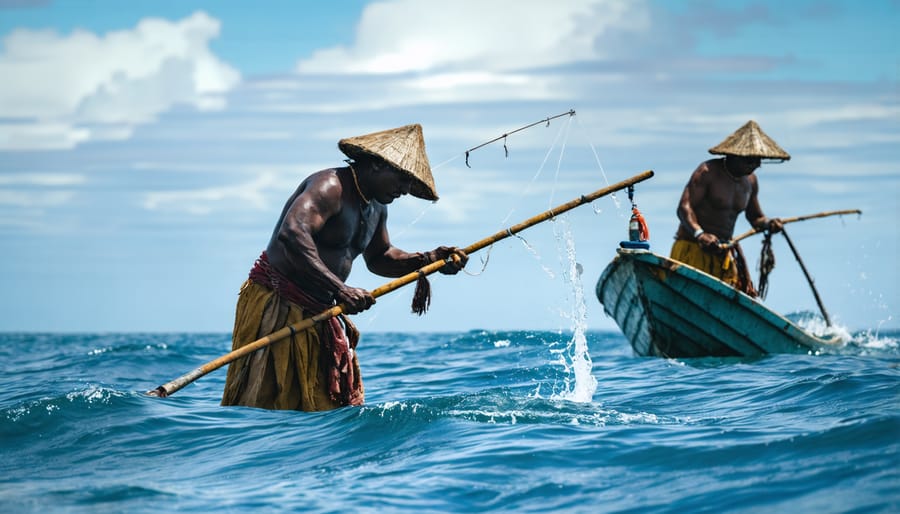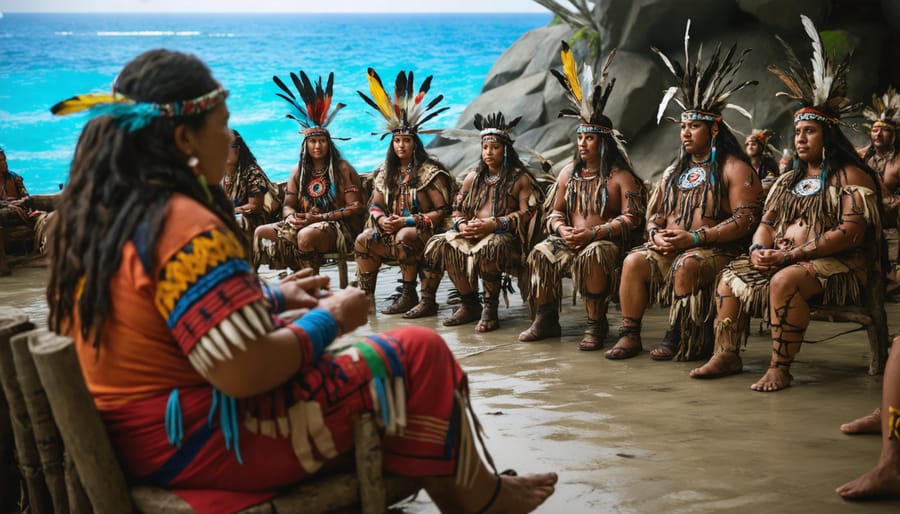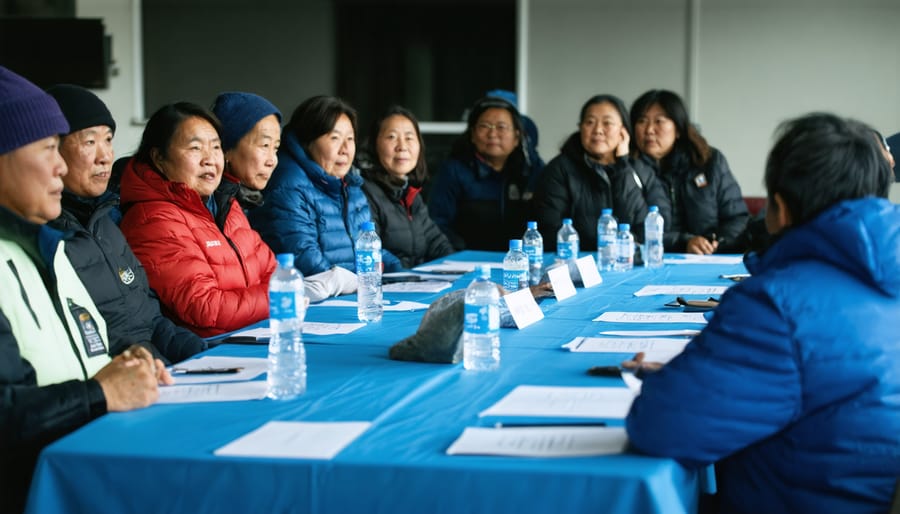
Indigenous peoples’ rights have emerged as a crucial cornerstone of international human rights law, with the United Nations playing a pivotal role in advancing their recognition and protection. The UN’s landmark Declaration on the Rights of Indigenous Peoples (UNDRIP), adopted in 2007, marked a watershed moment in acknowledging indigenous communities’ collective rights to self-determination, traditional lands, and cultural heritage. This framework has fundamentally transformed how nations approach indigenous sovereignty, resource management, and cultural preservation.
Through dedicated mechanisms like the Permanent Forum on Indigenous Issues and the Expert Mechanism on the Rights of Indigenous Peoples, the UN has created powerful platforms for indigenous voices to shape global policy. These institutions have been instrumental in addressing critical challenges facing indigenous communities worldwide, from land rights disputes to environmental protection and cultural preservation.
Today, as indigenous peoples continue to face unprecedented challenges from climate change, resource exploitation, and cultural erosion, the UN’s role in safeguarding their rights has become more vital than ever. Understanding this complex relationship between indigenous rights and international governance is essential for comprehending current global efforts to protect indigenous communities’ fundamental human rights and ensure their meaningful participation in decisions affecting their futures.
Traditional Marine Knowledge: A Foundation for UN Policy
Cultural Practices and Sustainable Fishing
Indigenous communities worldwide have developed sophisticated traditional fishing methods that reflect generations of ecological knowledge and sustainable resource management. These practices often incorporate seasonal fishing patterns, selective harvesting techniques, and cultural protocols that naturally limit catch sizes and protect breeding grounds.
Many indigenous fishing communities practice rotational harvest systems, where different areas are fished in sequence, allowing marine populations to recover. For example, Pacific Islander communities traditionally establish temporary fishing closures, or “tapu” areas, guided by their understanding of fish spawning cycles and coral reef health.
The United Nations has recognized that these indigenous practices often align perfectly with modern conservation goals. Studies have shown that areas managed under indigenous stewardship typically maintain higher biodiversity and more stable fish populations compared to areas under conventional management systems.
Recent UN initiatives have begun incorporating indigenous knowledge into marine protection strategies, acknowledging that traditional practices often provide effective solutions to contemporary conservation challenges. This integration has led to successful co-management programs where indigenous communities work alongside conservation authorities to protect marine resources.
These partnerships demonstrate how indigenous rights and environmental protection can work in harmony, creating more effective and equitable approaches to marine resource management. The success of these programs highlights the importance of protecting indigenous fishing rights while supporting global conservation efforts.

Knowledge Integration in UN Frameworks
The United Nations has made significant strides in integrating indigenous knowledge into its marine governance frameworks, recognizing that traditional practices and cultural heritage in marine conservation are crucial for sustainable ocean management. This integration process began with the establishment of the UN Permanent Forum on Indigenous Issues (UNPFII) and has evolved through various conventions and declarations.
Traditional ecological knowledge is now being systematically incorporated into UN marine policies through multiple channels. The Convention on Biological Diversity (CBD) specifically acknowledges indigenous peoples’ contributions to marine biodiversity conservation, while the UN Framework for Ocean Science incorporates traditional knowledge systems alongside modern scientific approaches.
A notable example is the Local Communities and Indigenous Peoples Platform (LCIPP), which facilitates the exchange of experiences and best practices for marine resource management. This platform enables indigenous communities to share their centuries-old understanding of marine ecosystems with international policymakers and scientists.
The UN has also established working groups that bring together indigenous knowledge holders and marine scientists to develop integrated approaches to ocean conservation. These collaborative efforts have led to more effective marine protected area management and sustainable fishing practices, demonstrating how traditional wisdom can complement modern conservation strategies.
Looking ahead, the UN continues to strengthen these knowledge-sharing mechanisms, ensuring that indigenous perspectives are not just acknowledged but actively integrated into global marine governance structures.
UN Declaration on Indigenous Rights: Marine Implications

Article 25: Rights to Coastal Waters
Article 25 of the UN Declaration on the Rights of Indigenous Peoples recognizes the profound relationship between indigenous communities and their traditional coastal waters. This crucial provision affirms indigenous peoples’ right to maintain and strengthen their spiritual connection with traditionally owned or occupied seas, coastal waters, and other marine resources.
Indigenous communities have sustainably managed coastal waters for millennia, developing sophisticated traditional ecological knowledge systems that combine resource management with cultural practices. These traditional approaches often align with modern conservation goals, emphasizing sustainable harvesting, habitat protection, and the preservation of marine biodiversity.
The declaration specifically protects indigenous peoples’ rights to own, use, develop, and control the waters and coastal territories they have traditionally owned or occupied. This includes the right to participate in decision-making processes affecting their marine resources and to maintain their customary practices of fishing, gathering, and marine resource management.
Many indigenous communities have successfully integrated their traditional knowledge with contemporary conservation efforts. For example, Aboriginal and Torres Strait Islander peoples in Australia have established Indigenous Protected Areas that include sea country, combining ancient wisdom with modern marine protection strategies.
The implementation of these rights faces ongoing challenges, including industrial fishing, coastal development, and climate change impacts. However, successful cases demonstrate that recognizing indigenous rights to coastal waters not only preserves cultural heritage but also contributes to marine ecosystem health and biodiversity conservation through time-tested sustainable management practices.
Article 32: Resource Management Authority
Article 32 of the UN Declaration on the Rights of Indigenous Peoples establishes a crucial framework for indigenous communities to exercise control over their traditional resources and territories. This provision empowers indigenous peoples with the authority to determine and develop priorities and strategies for the development or use of their lands, waters, and other resources.
The declaration requires states to consult and cooperate in good faith with indigenous peoples to obtain their free and informed consent before approving any project affecting their territories or resources. This principle, known as Free, Prior and Informed Consent (FPIC), represents a significant shift from historical practices where indigenous communities were often excluded from decision-making processes.
Indigenous resource management authority extends to both renewable and non-renewable resources, including marine resources in coastal areas. Traditional knowledge systems, passed down through generations, often incorporate sustainable management practices that have proven effective in maintaining biodiversity and ecological balance.
The implementation of this article has led to successful cases worldwide, where indigenous communities have established their own resource management systems. These include marine protected areas managed by indigenous peoples, sustainable forestry initiatives, and traditional fishing practices that ensure long-term resource viability.
However, challenges remain in fully realizing these rights, particularly when competing interests from industry and development projects arise. The international community continues to work towards strengthening enforcement mechanisms and supporting indigenous peoples in exercising their resource management authority effectively.
Success Stories: Indigenous-Led Marine Conservation
Pacific Islands Initiative
The Pacific Islands Initiative stands as a remarkable example of indigenous-led marine protection success, demonstrating how traditional knowledge and modern conservation practices can work in harmony. Launched in 2018, this collaborative effort spans across Polynesia, Micronesia, and Melanesia, bringing together over 30 indigenous communities to protect vital marine ecosystems.
The initiative employs traditional Pacific Islander practices such as “ra’ui” (temporary fishing closures) and “tabu” (sacred marine areas), integrating them with contemporary scientific monitoring methods. Local communities actively participate in marine surveying, coral restoration, and sustainable fishing practices, while maintaining cultural connections to their ancestral waters.
Notable achievements include the establishment of fifteen locally managed marine protected areas, covering approximately 12,000 square kilometers of ocean territory. These protected zones have shown significant increases in fish populations, with some areas reporting up to 30% growth in commercially important species within just three years.
The program’s success has attracted international attention, leading to increased funding from the United Nations Environmental Programme and serving as a model for other regions. Communities report improved food security, enhanced economic opportunities through sustainable tourism, and strengthened cultural identity through the revival of traditional marine management practices.
Through regular knowledge-sharing forums and youth education programs, the initiative ensures the transfer of both traditional and scientific knowledge to future generations, creating a sustainable framework for long-term marine conservation.
Arctic Council Collaboration
The Arctic Council serves as a pioneering model for indigenous participation in marine resource management, with six permanent indigenous organizations actively participating in decision-making processes alongside national governments. This unique collaborative framework ensures that traditional ecological knowledge and indigenous perspectives are integrated into policies affecting Arctic marine ecosystems.
Indigenous groups, including the Inuit Circumpolar Council and Saami Council, contribute valuable insights into sustainable fishing practices, marine mammal conservation, and climate change adaptation strategies. Their participation has led to more effective policies that balance conservation needs with traditional subsistence practices.
A notable success of this collaboration is the incorporation of indigenous knowledge into the Protection of the Arctic Marine Environment (PAME) working group’s initiatives. Traditional hunting and fishing practices, passed down through generations, have informed sustainable harvest guidelines and protected area designations throughout the Arctic region.
The Council’s emphasis on consensus-building has created opportunities for indigenous communities to influence international agreements on shipping routes, resource extraction, and marine protected areas. This approach has proven particularly valuable in addressing emerging challenges like changing migration patterns of marine species and the impact of melting sea ice on traditional hunting grounds.
Recent initiatives have focused on developing community-based monitoring programs, where indigenous observers work alongside scientists to track marine ecosystem changes, demonstrating how traditional and scientific knowledge can complement each other in marine resource management.

Future Directions and Challenges
Climate Change Impacts
Indigenous communities face disproportionate impacts from climate change, particularly affecting their traditional marine resources and ways of life. Rising sea levels threaten coastal communities, while ocean acidification and warming waters disrupt traditional fishing grounds and marine ecosystems that have sustained indigenous peoples for generations.
Many small island nations and coastal indigenous communities report significant changes in fish migration patterns and declining fish populations, directly impacting their food security and cultural practices. In the Arctic, indigenous peoples witness rapid ice melt affecting traditional hunting grounds and threatening marine mammals essential to their subsistence lifestyle.
The United Nations has recognized these challenges through various forums, including the Permanent Forum on Indigenous Issues, which highlights how climate change undermines indigenous rights to traditional marine resources. Indigenous communities often serve as early warning systems for climate change impacts, with their traditional ecological knowledge providing valuable insights into environmental changes.
Despite these challenges, indigenous peoples demonstrate remarkable resilience and adaptation strategies. Many communities actively participate in international climate change discussions, sharing traditional knowledge and advocating for stronger climate action while maintaining their rights to marine resources. Their experiences and solutions increasingly inform UN climate policy and marine conservation efforts.
Strengthening Indigenous Voice
The United Nations has made significant strides in amplifying indigenous voices through various initiatives and reforms. The UN Permanent Forum on Indigenous Issues (UNPFII), established in 2000, serves as a crucial platform where indigenous representatives can directly participate in UN discussions and decision-making processes. This forum has been instrumental in promoting community engagement in conservation efforts and resource management.
Recent developments include the creation of the Indigenous Peoples’ Partnership (UNIPP), which coordinates UN activities supporting indigenous peoples’ rights. The partnership focuses on capacity-building, enabling indigenous communities to effectively engage in international forums and advocate for their interests in marine resource management.
The UN has also implemented measures to ensure indigenous participation in climate change negotiations, particularly concerning ocean conservation and coastal resource management. Indigenous observers are now regularly included in key UN meetings, bringing traditional ecological knowledge to global environmental discussions.
Despite these advances, challenges remain in achieving full and effective participation. Many indigenous communities face practical barriers such as language differences, limited funding for travel, and complex bureaucratic procedures. The UN continues to work on addressing these obstacles through targeted support programs and simplified participation mechanisms.
The recognition of indigenous rights in marine conservation represents a crucial shift towards more equitable and effective environmental stewardship. By integrating traditional ecological knowledge with modern conservation practices, we create stronger, more resilient approaches to protecting our oceans. The United Nations’ commitment to indigenous rights has demonstrated that when local communities are empowered as decision-makers, marine conservation efforts are more successful and sustainable.
Throughout this discussion, we’ve seen how indigenous peoples’ deep connection to marine ecosystems, developed over generations, provides invaluable insights for conservation strategies. Their traditional practices often align perfectly with sustainable resource management, offering proven solutions to contemporary challenges. The UN’s frameworks have helped legitimize these approaches on the global stage, creating opportunities for meaningful collaboration between indigenous communities and conservation organizations.
Looking ahead, the continued recognition and implementation of indigenous rights will be vital for addressing marine conservation challenges. Success stories from various regions demonstrate that when indigenous communities are given proper authority over their traditional waters, marine biodiversity thrives. This approach not only preserves ecological systems but also protects cultural heritage and promotes social justice.
As we face increasing threats to marine ecosystems, the partnership between indigenous peoples and the international community becomes ever more critical. By supporting indigenous rights and traditional knowledge systems, we invest in proven solutions for marine conservation while advancing human rights and environmental justice.
jessica
Ava Singh is an environmental writer and marine sustainability advocate with a deep commitment to protecting the world's oceans and coastal communities. With a background in environmental policy and a passion for storytelling, Ava brings complex topics to life through clear, engaging content that educates and empowers readers. At the Marine Biodiversity & Sustainability Learning Center, Ava focuses on sharing impactful stories about community engagement, policy innovations, and conservation strategies. Her writing bridges the gap between science and the public, encouraging people to take part in preserving marine biodiversity. When she’s not writing, Ava collaborates with local initiatives to promote eco-conscious living and sustainable development, ensuring her work makes a difference both on the page and in the real world.
